- Blog
- How to Plan and Write Automotive Content That Ranks on Google
How to Plan and Write Automotive Content That Ranks on Google
Writing car content can be easy with these SEO tips, keyword research strategies, and effective content writing techniques. Boost your dealership’s visibility on Google!

Would you like to attract more customers and drive more sales to your car dealership? If so, you have to make your dealership visible on Google.
The best way to boost your website’s ranking on Google and other search engines is to create relevant content. In your case, spreading knowledge about the automotive industry is best.
To ensure you’re using your resources effectively, you should approach automotive content marketing strategically. We can help you out here! This article will guide you through crucial content-writing strategies that are simple, successful, and easy to act on.
Understanding automotive SEO and how it works
Automotive content marketing revolves around search engine optimization (SEO). By learning about SEO basics for car dealerships, you can create content that better meets the criteria that search engines use to rank pages.
For instance, using relevant keywords throughout your content and ensuring your website is mobile-friendly are two simple yet effective SEO tactics.
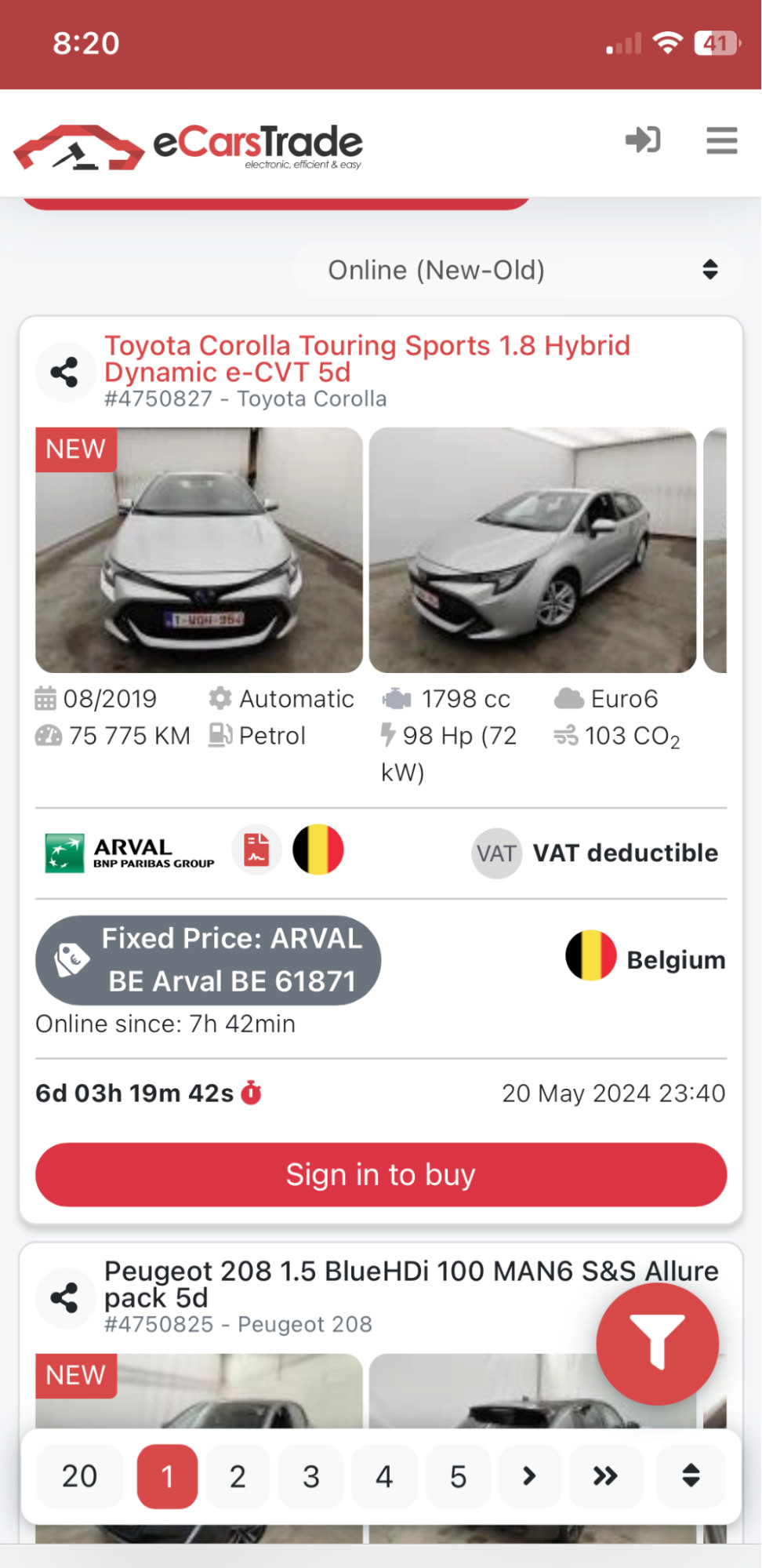
An example of a mobile-friendly page
Using such tactics will help you create content that appeals to your target audience and ranks well on Google, attracting more visitors and potential buyers.
The first step of your car content strategy should be keyword research, so we’ll give you some pointers about choosing the right keywords successfully.
Let’s start with keyword research for automotive content creation
Keyword research is exactly what it sounds like: it’s finding the words and phrases that potential customers use when they search for products or services related to your business.
Using the right tools for identifying keywords will make the process run more smoothly, and we’ll now show you our favorites.
Tools for finding the best keywords for dealerships
Car buyers always go for a test drive before cashing out for a vehicle. We suggest you do the same—feel free to test out the keyword tools to see which ones suit your needs best.
There are many great options that you can use for free. Here are some that we’ve found efficient:
You can take a peek into WordStream in the screenshot below to see what you can expect.
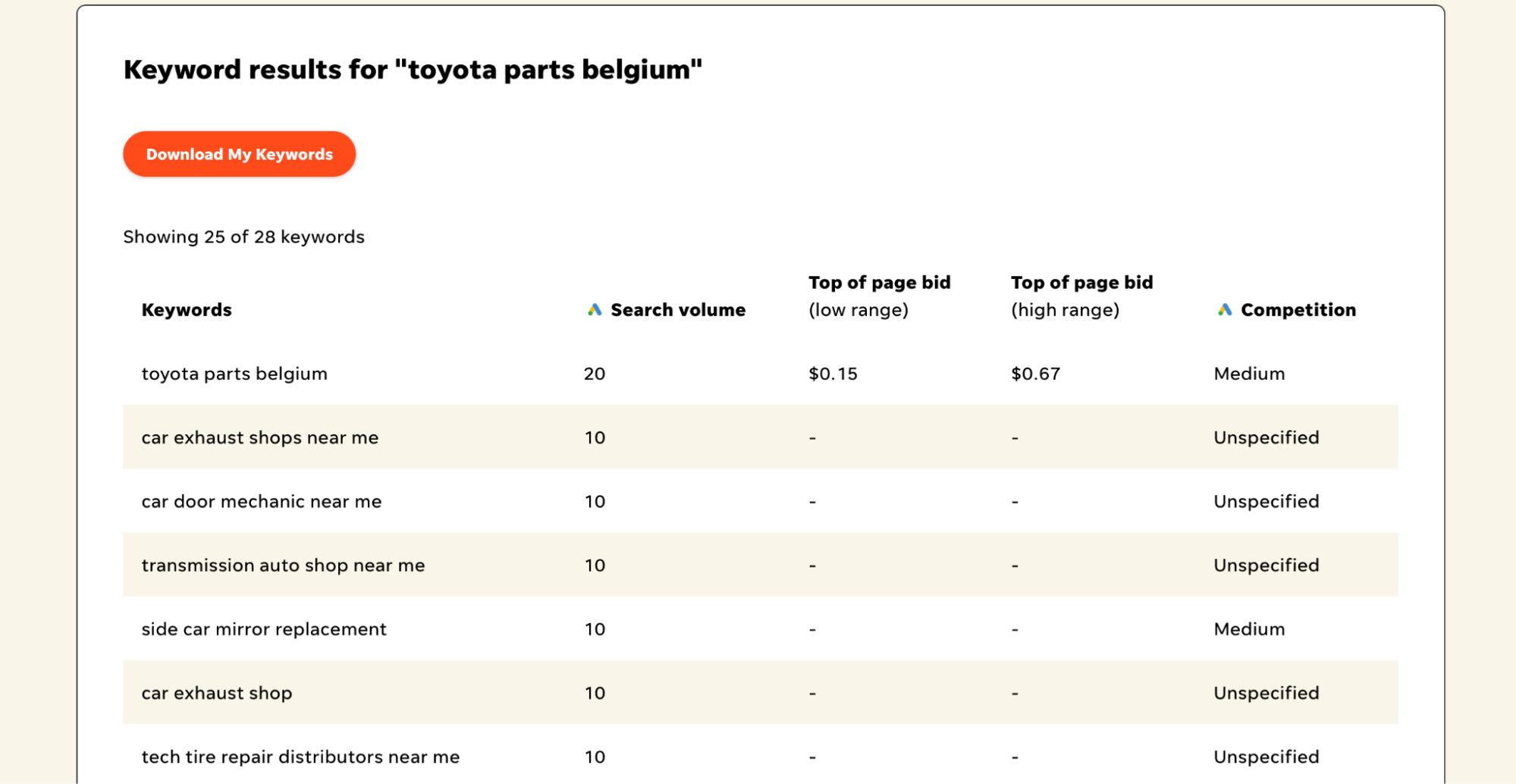 Source: WordStream
Source: WordStream
Essentially, if you want to target customers looking for, for example, Toyota parts in Belgium, WordStream will suggest mentioning phrases like car exhaust shop in your content.
If you’re looking for more robust features, you can explore paid tools for keyword research. We like the following ones:
Although these tools require monthly payments, they offer benefits such as more detailed insights into your competitors, ranking tracking, and more.
Don’t forget that each of these tools offers a free trial, so that’s something to explore before committing.
Divide keywords by landing pages
Once you’ve gathered your keywords, the next step is to divide them by landing pages.
This technique helps you avoid keyword cannibalization—in other words, it ensures that your web pages aren’t competing against each other for attention.
We’ll now see some ideas of how you can divide keywords to where they matter the most, ensuring that each page attracts the right audience.
|
Landing page |
Keywords |
Purpose |
|
Homepage |
Trusted car dealership, affordable used cars |
Overview of your dealership |
|
Used cars page |
Used cars deals near Rotterdam, pre-owned cars |
Attract buyers looking for used cars in your specific area |
|
Finance page |
Auto loans, car financing options |
Help customers understand their financing options |
|
Service and parts page |
OEM car parts, auto repair shop |
Draw in customers needing maintenance or parts |
Covering different keywords on different pages ensures that each page is optimized to attract traffic for specific searches.
This strategic placement boosts the visibility of your entire website, making it easier for potential customers to find exactly what they need, whether it’s a new car, a used vehicle, or service options.
How to plan & write content for your blog and landing pages?
Well done, you’re now finished with keyword research! Now it’s time for automotive content writing.
Before you jump into writing, remember that organizing your information clearly helps your readers to follow along and lets search engines recognize the value of your content.
Let’s see how you can achieve that.
How should your content be structured?
The method is surprisingly straightforward! You only need to look up the keyword you’re targeting and analyze the top ten results.
For instance, here’s what one of the top ten results for the keyword “buying EV tips” includes.
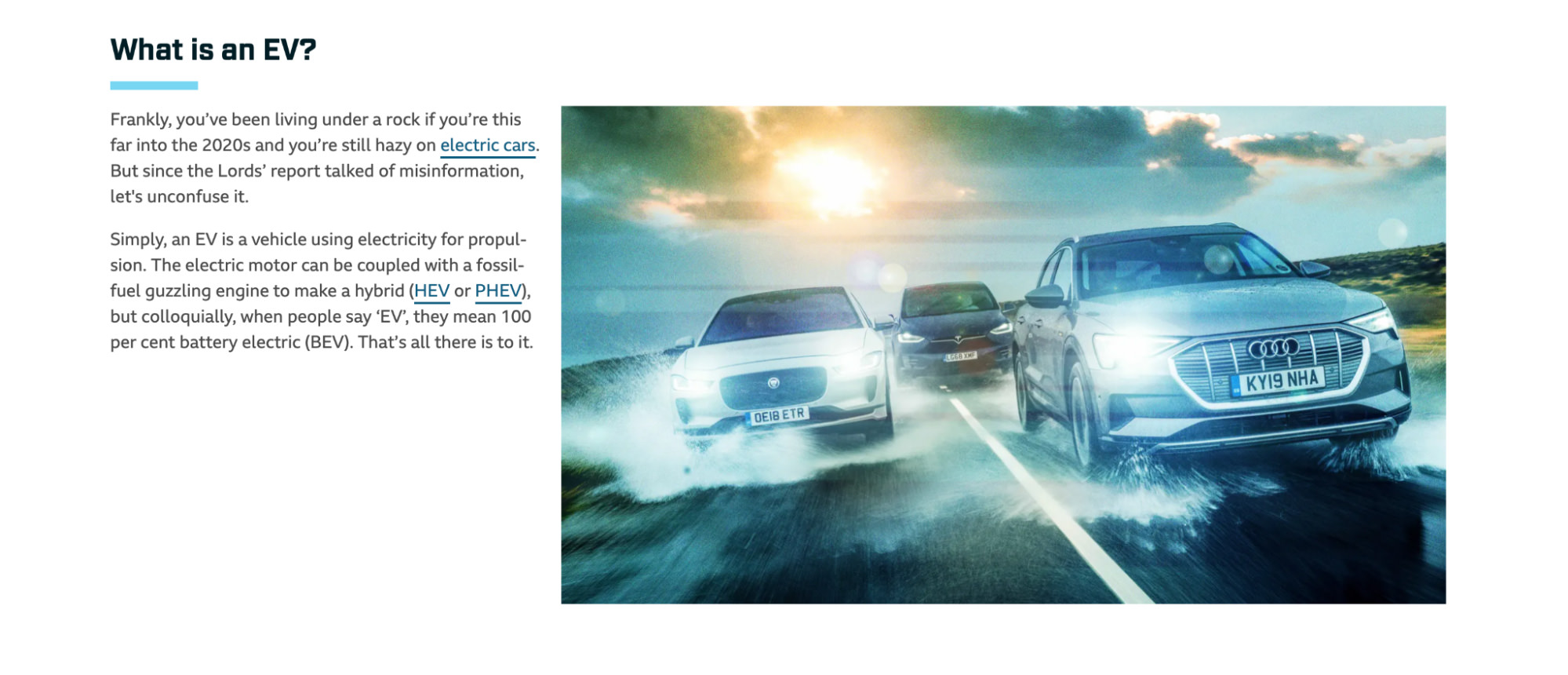 Source: Top Gear
Source: Top Gear
The blog post starts with a short explainer of EVs, and then lists tips for buyers. These include checking battery health, looking at the car’s service history, and more.
So, if you were also writing about EVs, it would be wise to offer a short definition of these vehicles.
Mimicking the structure of successful posts will let you create informative and SEO-friendly content.
Still, make sure your content is original and avoid plagiarization at all costs—Google doesn’t quite appreciate copied material.
To sum up: you should borrow the structure from others but create unique content on your own.

Write engaging and informative content
Good content doesn’t only refer to SEO-friendliness. You should keep your actual readers in mind, and write in a way that provides them with valuable information.
We’ve prepared three quick yet crucial tips for automotive content writing:
- Use simple language: Avoid complex jargon and explain terms when necessary to ensure all readers can easily understand.
- Solve problems: The readers have visited your website for a reason. Instead of writing just to fill pages, address the issues and questions the readers may have by providing clear, concise solutions.
- Engage visually: Images, graphics, and videos break up the text, making it more accessible and appealing to readers. Remember to take great photos of your vehicles, too.
Pair these tips with customer testimonials or your experts’ insights, and you’ll position yourself as an automotive authority, making the readers confident in your knowledge.
Try to incorporate keywords naturally
Next, you should be mindful of keyword stuffing. That’s the practice of excessively cramming keywords into your content in an unnatural way, which can harm your SEO efforts rather than help them.
You can see how strange it looks below.
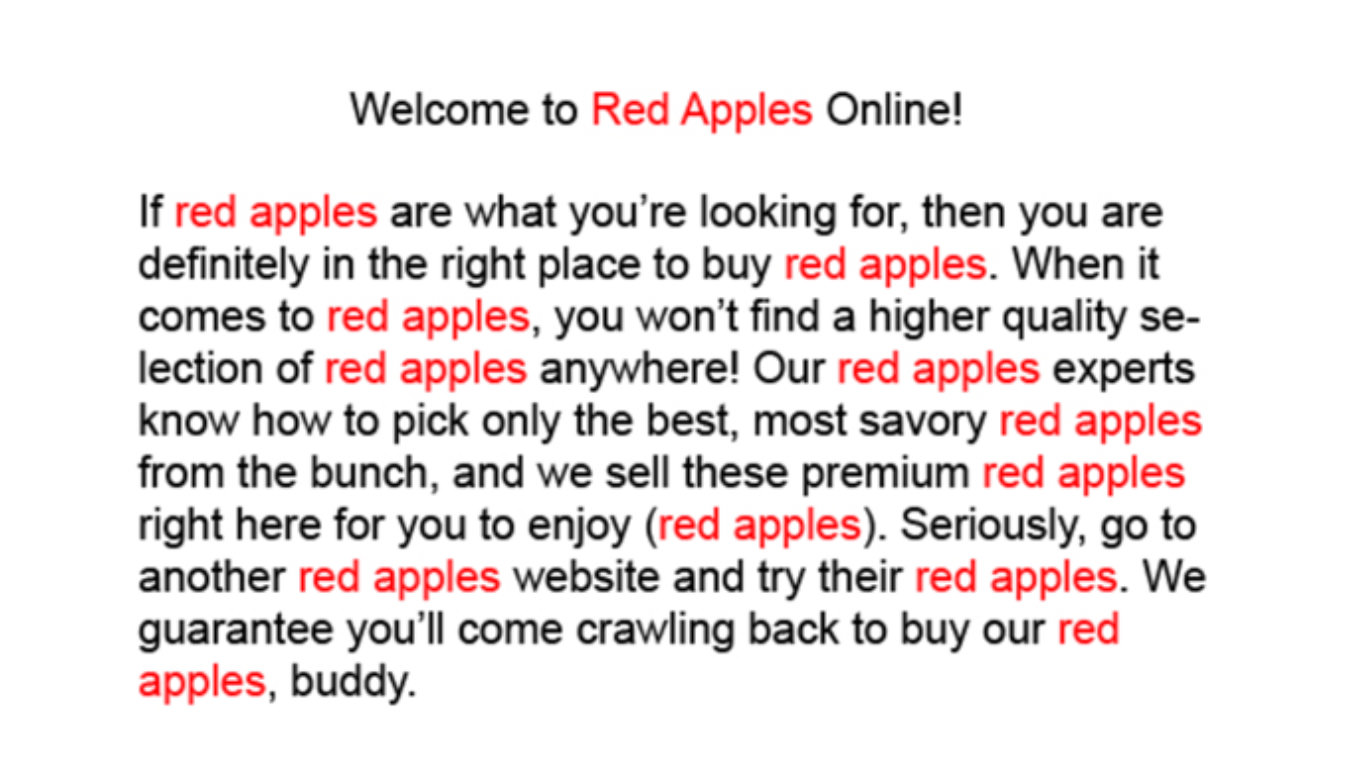
Source: Cyberclick
Not what you’d like your website to look like, right?
Instead, you should sprinkle your targeted keywords throughout your content where they fit naturally. If you cover the topic you’re writing about accurately and thoroughly, most keywords should already be there.
It’s a win-win situation for both customers and search engines.
Remember about on-page SEO optimization!
After writing your blog posts or other pieces of car content for your website, you can still take a few additional steps to get a better ranking on Google.
These details can make a big difference in how Google sees your site, and we’ll show you three of the most important ones.
Optimize title tags
In a nutshell, title tags are clickable headlines appearing in search engine results and telling users and search engines what your page is about.
Since your aim is to get users to visit your site, your title tags should be descriptive, concise, and to the point. Of course, they should also include your targeted keyword.
Take one of our own title tags, for example. Here’s how our blog post about transporting multiple vehicles within the EU appears on Google.
And here it is in a Safari browser tab.

As you can see, we’ve used the limited space to tell our readers what they can expect from the article, attracting them to click the link and visit our website.
Write appealing meta descriptions
Similarly, meta descriptions are the elements that summarize the content of your page.
If a meta description is attractive, readers will engage with your content. If not, well, they might go to your competitors instead.
That’s why you should write meta descriptions that use active voice, include your targeted keyword, and are concise and specific.
You can see a great example below.
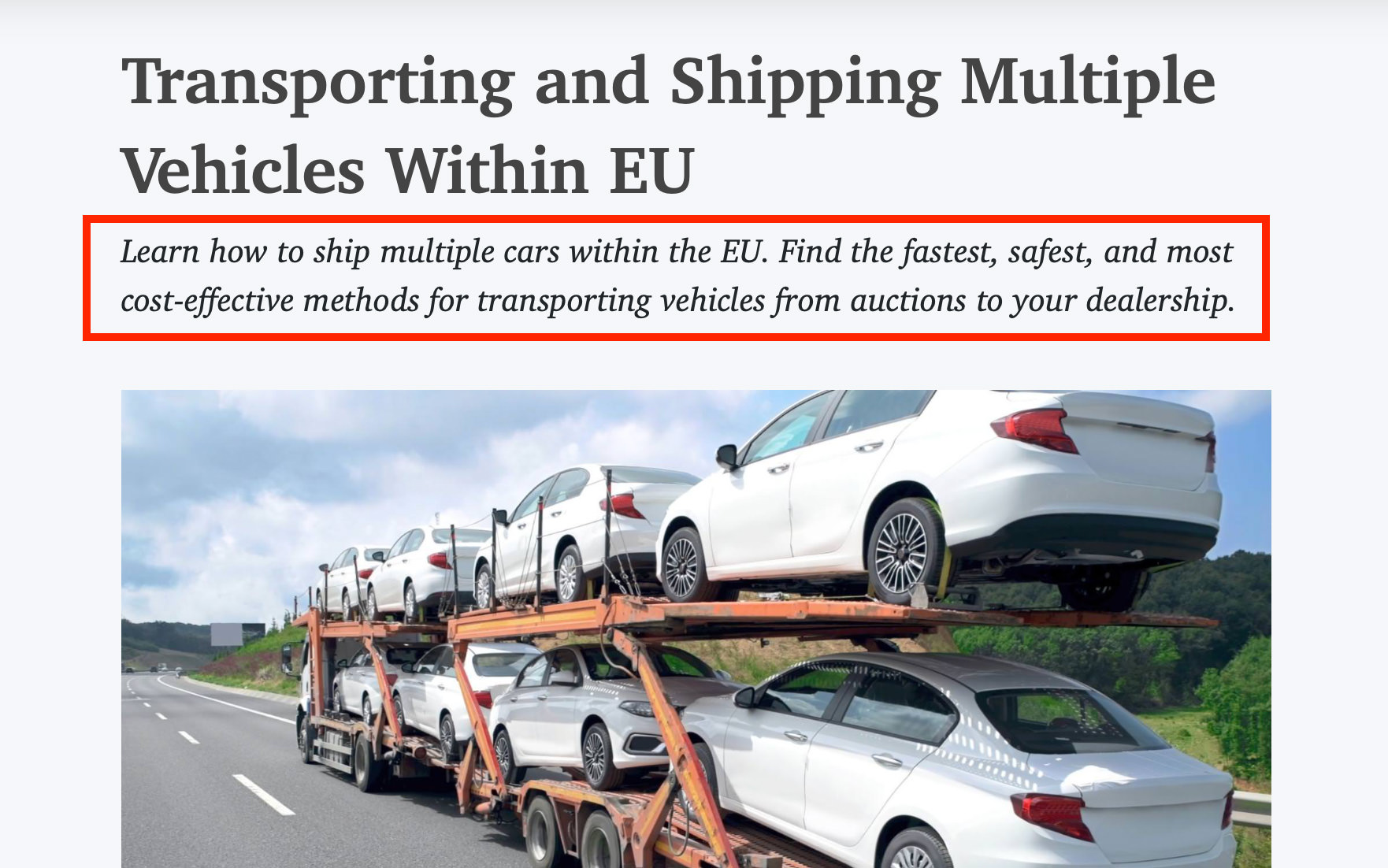

Or

Need another example?
Sure, we’ve got you! Here’s an idea of what to do and what not to do.
✅ Discover affordable used cars at our dealership. Find your perfect car today!
❌ We offer a wide range of cars. Visit our website to learn more about our inventory and services.
As long as you’re focused on the reader and keep the text concise, your meta descriptions are good to go.
Avoid using only AI-generated content
We know—it can be rather tempting to use content-generation tools and post ten blog posts daily.
Still, such content is often repetitive and generic, as you can see below.
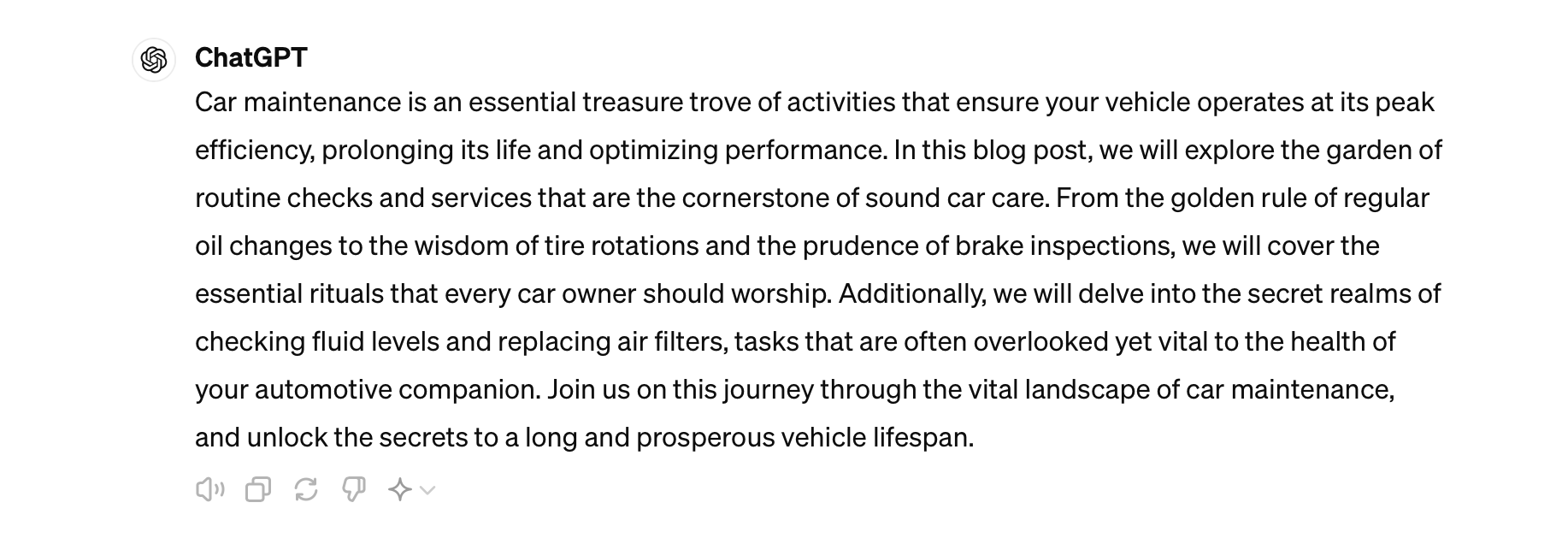 Image source: ChatGPT
Image source: ChatGPT
Did you read this wall of nonsense about car maintenance?
Probably not. Nor would your readers!
To truly connect with the readers (whose user behavior will then positively impact Google ranking), it’s better to invest in creating quality content enriched with human insight.
AI tools are excellent for providing car content ideas or basic frameworks, but it’s best to use them as a supplement to your unique perspectives and knowledge.
Also, fostering customer loyalty requires genuine engagement, so that’s another reason to prioritize human-generated content over relying solely on AI.
How to write content for your dealership: a summary
Whew, this was quite a read!
To help you out, we’ve prepared a checklist of measures to take when it comes to creating automotive content.
- Explore the world of SEO: Learn and apply basic SEO principles like using relevant keywords or focusing on customer experience.
- Find the right keywords: Use specialized tools to identify relevant keywords your customers are searching for.
- Organize your keywords: To avoid keyword cannibalization, strategically assign specific keywords to specific pages.
- Structure your content well: Analyze the top-ranking content and model your structure on successful examples, but ensure your content remains unique.
- Make the content engaging: Keep it simple, solve reader problems, and use visuals to make your content more engaging.
- Optimize key elements: Pay attention to title tags and meta descriptions to enhance your SEO and improve organic CTR.
- Don’t rely only on AI: AI should be your helper, not your replacement.
So, if you ever want to double-check that you’re doing everything right to make your dealership more visible on Google, this list will be waiting for you here.
And if you’re looking to expand the fleet that your dealership offers, take a look at our used cars for sale.
We wish you loads of first-page results!
eCarsTrade offers online auto auctions of ex-lease vehicles from France, Belgium, The Netherlands and Germany, with a complete maintenance history. We guarantee high quality of our vehicles, and a fast, simple and transparent purchasing process with fixed commission costs. We work with both European and international used car dealers and traders. Your dedicated Account manager is your personal support for any questions or issues!
BROWSE CARS

